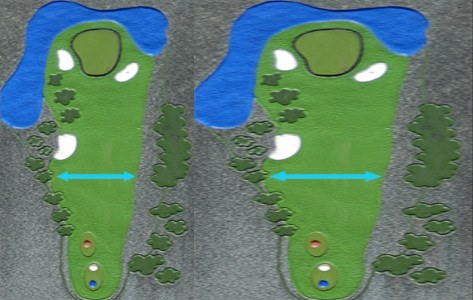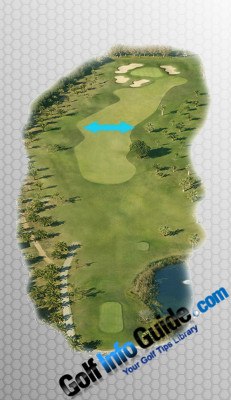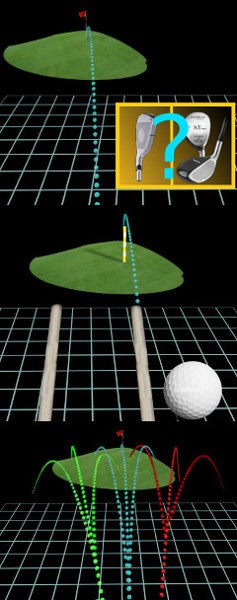
Just as golfers tend to tighten up at the sight of a thin fairway hemmed in by trees, rough or hazards, we often relax when faced with a wide playing alley unbound by trouble.
Relaxation is a good thing, of course – as long as you don't ignore the details.
Wide fairways have come into vogue recently, and the trend figures to expand in the coming years. One reason: Modern designers have rediscovered the strategic value of broad fairways. Another: Golf courses are keen to speed up play, and nothing slows things down worse than golfers hunting for balls or hacking from thick rough.
Where's the strategy in a wide fairway? The Old Course at St. Andrews – the home of golf and the wellspring of course design – is famous for its vast playing corridors. Each hole offers a more favorable line of play, giving an advantage to the golfer who finds and follows it vs. the one who doesn't. Augusta National Golf Club, site of the Masters Tournament, was built with similar qualities before recent changes narrowed it considerably.
And another thing: Knowing the average golfer will let down his guard when there's little fear of driving into trouble, course designers craft holes to favor astute players who drive to specific spots.
Here's the message: Just because a fairway is ample doesn't mean you should carelessly declare, “Bombs away!” A haphazard tee shot may leave you with a blind approach, or one that must carry a deep bunker or water. Identify the best angle to the green and aim your drives precisely at that spot.
Every golfer loves the feeling of stepping up onto the tee and seeing a wide fairway stretching out toward the green.

With so much short grass to work with, you may feel like there is no way you can go wrong. After all, even if you miss your target by a fair margin, you should still be able to grab a piece of the fairway with your drive. Seeing such a wide landing area is likely to fill you with confidence, and that confidence will hopefully translate to a great swing.
Unfortunately, things don't always play out as nicely as they sound in that opening paragraph. Despite having a huge fairway to work with, there is no guarantee that you will find the short grass off the tee. If you hit a bad shot, such as a hook or a slice, the ball is likely to curve enough to miss even the widest of fairways. There is no such thing as an easy shot in golf, and this is a perfect example of that notion. If you take this kind of tee shot for granted, you will pay the price sooner or later.
In this article, we are going to provide you with some strategies for dealing with extra wide fairways. You might not think that you need any kind of strategy on such a hole, but that kind of thinking is going to get you into trouble. Every shot you play from the first tee to the last green should be planned in some form or fashion. The beauty of playing to a wide fairway is that you do have some extra margin for error. As long as you think through the shot carefully, and as long as you focus on executing a great swing, you should come out okay most of the time.
All of the content below is based on a right-handed golfer. If you happen to play left-handed, please take a moment to reverse the directions as necessary.
Understanding the Risks

Believe it or not, there are plenty of risks associated with hitting a tee shot to a wide fairway. In this section, we are going to outline the various ways in which this kind of shot can go wrong. We aren't trying to scare you, but rather we are trying to get your attention. We don't want you to slip into a false sense of security when you stand on the tee, as this could lead to trouble. By explaining how many different ways it is possible for a seemingly easy tee shot to go wrong, you will be more likely to give these kinds of shots your full attention.
Without further delay, let's look at some of the problems you may encounter in this situation.
- Complacency. The first, and perhaps, biggest hurdle you will need to clear on this kind of shot is complacency. Simply put, you may take a tee shot to a wide fairway for granted, thinking it will be easy to place your ball in a good position. When you fail to focus, you are more likely to make a poor swing. Suddenly, you will have greatly reduced your chances at success just because you decided that you didn't need to give the shot your full attention. Every shot you play, from the first to the last, deserves your attention. By taking a consistent, methodical approach to this game, you can improve your performance over time. Treat all of your tee shots the same, whether the fairway is a narrow ribbon or a wide expanse.
- Finding a hazard. Often, course designers will combine a large fairway with some form of hazard to create an interesting layout. This type of design gives a hole nice balance. You are given a wide fairway to work with, so you do have a good chance to find the short grass, but a severe punishment is waiting if you make a mistake. The classic example of this is a hole with a water hazard running down the side of the fairway from tee to green. For example, picture a long par with a pond guarding the left side of the wide fairway. If you make a good swing, you'll have no trouble finding a spot in the big fairway for your ball to settle. However, if you miss to the left, the shot will surely find the water and you may be headed for a double bogey or worse. Don't be surprised if you find the holes with the widest fairways also come with some of the most worrisome hazards.
- Getting out of position. It is easy to assume that placing your ball anywhere in the fairway will be a successful outcome. That is not necessarily the case, however. Sometimes, you will hit the fairway only to find when you arrive at your ball that you don't have a very good look at the target. Or, in some extreme cases, you might not have any look at the target at all. With this in mind, you should be thinking about your second shot while you are still standing back on the tee. Where in the fairway do you want to be in order to set up a good angle for the approach? We will talk a bit more about this in the next section.
- Leaving a long second shot. Just as course designers will often use wide fairways when a hazard is in play, they will also lean toward big fairways when the hole is going to have considerable length. This is another way to balance the challenge – by giving you plenty of room to work with, they allow you to make an aggressive swing at your driver in an attempt to set up a reasonable second shot. Of course, you are only going to set up that reasonable second shot if you strike the ball cleanly off the tee. It is one thing to hit the fairway. It is another thing entirely to hit the ball hard enough to put yourself in position for an easy approach to the green. Later in the article, we will talk about the keys you can use to make a quality swing when you face this situation.
- Placing your ball on an uneven lie. The last point on our list has to do with finding a flat place to play from on your second shot. Again here, we see that simply hitting the fairway might not be enough to consider the tee shot a good one. Picture a wide fairway that has a dramatic slope in the middle, going down from right to left. The right side of the fairway is the high side, and the left side is the low side. Both sections are relatively flat and would offer a good place to play from, but the middle is severely slope and would lead to a challenging approach. Obviously, you will need to do what you can to stay away from the center of the fairway in this case. You'll want to pick out the right or left side as your intended target before you ever take your stance over the ball. It is always a good idea to look for a relatively flat landing spot for your tee shots, no matter the width of the fairway.
As you can see, there are plenty of ways in which this type of tee shot can go wrong. Or, even if you hit the fairway and it seems like the tee shot worked out fine, you may wind up discovering that you aren't really in the right section of the fairway to allow for an easy approach. The lesson here is simple – you need to think these tee shots through carefully. They aren't to be taken for granted, as you can get in trouble on these holes just like you can get in trouble on any other golf hole. In the following section, we will discuss how you can create a plan when standing on the tee of a hole with a wide fairway.
Planning for Success

By this point, we hope that you understand the importance of having a plan for all of your shots, including those played to wide fairways. Every shot you play during a round of golf has the potential to go wrong in one way or another. The course is doing you a favor by presenting you with a wide fairway, the last thing you want to do is waste that chance. Let's take a look at how you can plan out this kind of drive to be successful on most occasions.
- Pick a club first. Don't just assume that you are going to use your driver on this tee shot. It may wind up that the driver is the right tool for the job, but that is not a given. Take everything into account when surveying the path from the tee to the green. First, how long is the hole? If this is a relatively short hole, you might not want to use your driver, even though the fairway is wide. Also, consider any hazards that are waiting to catch an errant shot. If there is big trouble waiting to one side or the other, clubbing down for control may be the right decision. Once you have picked a club and you are confident in your selection, you can feel free to move on to the next step in the process.
- Find the hole location. The location of the hole on the green will have a lot to do with how you decide to aim this tee shot. Usually, you are going to want to be on the opposite side of the fairway from the hole. So, when the hole is cut on the right side of the green, you'll want to be in the left half of the fairway. Or, if the hole is on the left, you'll want to favor the right. Typically, this will give you the best possible look at the hole with your approach shot, although there are exceptions to every rule. As long as it is possible to see the green from the tee, check on the hole location and select your target line accordingly.
- Pick a specific target. At this point, you should know roughly where you want to hit the ball off the tee. Now, you are going to take that rough idea and turn it into a specific target. Use something very precise out in the distance to serve as your aim point for this drive. If there is a tree beyond the fairway that happens to be directly on your line, use that. Or, if playing a course in a developed area, you might be able to use a house or other structure in the distance for your aiming purposes. You aren't planning to reach these items with your shot, of course, but rather you are using them to give yourself an exact aim point. Then, when you step up to take your stance, you can orient your body and the club face using the point you selected.
You only need to work through the three steps above in order to set yourself up for success on a hole with a wide fairway. By going through the process of checking off these three points, you will engage your mind and take the shot seriously. It is hard to be complacent when you are so invested in the process of picking a smart target. The only thing left to do is make a great swing. We will tackle that subject in the following section.





